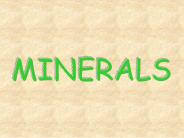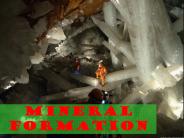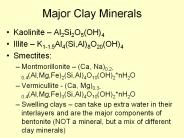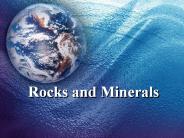Gypsum Mineral PowerPoint PPT Presentations
All Time
Recommended
Creates a net negative charge (and property of cation exchange capacity) ... Also has CEC, but little or no expansion. Other secondary mineral groups: oxides ...
| PowerPoint PPT presentation | free to download
Element loss varies with ionic potential Mineral Particle Size and Mineralogy Gravel 2mm (primary) Sand = 0.05 to 2.0 (primary) Silt
| PowerPoint PPT presentation | free to download
Non metallic mineral reserves consist of stone quarries and clay and sand pits; chemical and fertiliser mineral deposits; salt deposits; deposits of quartz, gypsum, natural gem stones, asphalt and bitumen, peat and other non metallic minerals other than coal and petroleum.
| PowerPoint PPT presentation | free to download
Supplier of Non Metallic Minerals Allied Mineral Industries http://www.alliedtalc.com/manufacturer-of-non-metallic-minerals.php Non-metallic mineral reserves consist of stone quarries and clay and sand pits; chemical and fertilizer mineral deposits; salt deposits; deposits of quartz, gypsum, natural gem stones, asphalt and bitumen, peat and other non-metallic minerals other than coal and petroleum.
| PowerPoint PPT presentation | free to download
Mineral Identification Practice Tutorial ESRT Mineral Chart Metallic Minerals Non-Metallic Minerals Non-Metallic Minerals Non-Metallic Minerals Mineral Identification ...
| PowerPoint PPT presentation | free to view
The Rock Cycle Rocks: a solid collection of minerals or mineral materials.
| PowerPoint PPT presentation | free to view
Title: Bellringer 1. Look at the 3 pictures. List as many difference as you can think of between the 3 things. 2. You have 3 minerals at your desk.
| PowerPoint PPT presentation | free to view
... halite, gypsum, calcite Minerals from Hot Water Solutions Elements and compounds dissolve Vein narrow channel or slap of a mineral different from the ...
| PowerPoint PPT presentation | free to view
Minerals - Cobb Learning ... Minerals
| PowerPoint PPT presentation | free to view
ENR- Types of Non-Metallic Luster Vitreous glassy looking, like quartz Silky um ... Minerals PowerPoint Presentation Definition of a Mineral ...
| PowerPoint PPT presentation | free to view
Minerals Building Blocks of Rocks 1
| PowerPoint PPT presentation | free to view
Minerals Building Blocks of Rocks
| PowerPoint PPT presentation | free to download
Formation, Characteristics and Identifying Properties Why study minerals? Minerals are important in our everyday lives... Some Uses (from USGS web site) Drywall is ...
| PowerPoint PPT presentation | free to download
1. _____- a naturally occurring, inorganic, crystalline solid with a definite chemical composition mineral A. Naturally occurring - made by _____- not man-made ...
| PowerPoint PPT presentation | free to view
... Ex. Gypsum [plaster] Halides Ex. Halites [salt]
| PowerPoint PPT presentation | free to download
Chapter 3 Minerals Minerals: naturally occurring, inorganic solids, with definite structure and composition; made of one or more elements Characteristics of Minerals ...
| PowerPoint PPT presentation | free to view
Title: Minerals of the Earth s Crust Author: Effingham County Last modified by: bbonorato Created Date: 6/2/2003 3:24:35 PM Document presentation format
| PowerPoint PPT presentation | free to download
Minerals Background Information Element: a substance made up of only one kind of atoms Example: Gold (Au), Aluminum (Al) Compound: a mixture of two or more elements ...
| PowerPoint PPT presentation | free to view
Title: Introduction Geology 1303 Earth Science Author: Kate C. Miller Last modified by: CUSD95 Created Date: 12/28/1999 5:24:29 AM Document presentation format
| PowerPoint PPT presentation | free to download
PowerPoint Presentation
| PowerPoint PPT presentation | free to download
The hardness of a mineral is its resistance to being scratched. Diamond is the hardest of all minerals, and talc is the softest. Friedrich Mohs devised a hardness scale.
| PowerPoint PPT presentation | free to view
VOLCANO - landforms generated when magma is. released from the Earth's ... VOLCANOES AND VOLCANISM. Soufriere Hills, Montserrat. I don't know where I'm a gonna ...
| PowerPoint PPT presentation | free to download
Title: PowerPoint Presentation Author: Tech nology Last modified by: Cherry_Guentzel Created Date: 1/6/2005 5:40:05 PM Document presentation format
| PowerPoint PPT presentation | free to view
Minerals Integrated Science I Minerals Naturally occurring inorganic solids made of a single element or compound Mineral Facts Over 3,000 minerals exist About 30 ...
| PowerPoint PPT presentation | free to download
Of the almost 3000 known minerals, only about 30 are common. ... Topaz has a hardness of 8. Hardness. Corundum (left) has a hardness of 9 ...
| PowerPoint PPT presentation | free to view
A crystal is a solid in which the atoms are arranged in ... Calcite. 3. Fluorite. 4. Apatite. 5. Feldspar. 6. Quartz. 7. Topaz. 8. Corundum. 9. Diamond. 10 ...
| PowerPoint PPT presentation | free to view
the color of the mineral in its powdered form ... The color of a mineral in its powdered form. Back to Geopardy Main Page. Define cleavage ...
| PowerPoint PPT presentation | free to view
Are the result of the internal arrangement of atoms within the mineral. ... When in doubt, ask yourself, 'does this mineral shine like a chrome faucet? ...
| PowerPoint PPT presentation | free to view
2. Two ways in which minerals can form- 1) crystallization of magma, 2) ... When ancient seas slowly evaporated, minerals formed (halite, gypsum, calcite) ...
| PowerPoint PPT presentation | free to view
Mineral Vocabulary Luster Mohs hardness scale Mineralogist Streak Fluorescence Density Refraction Cleavage Inorganic Mineral Silicate mineral Non-silicate mineral
| PowerPoint PPT presentation | free to download
Mineral Vocabulary Luster Mohs hardness scale Mineralogist Streak Fluorescence Density Refraction Cleavage Inorganic Mineral Silicate mineral Non-silicate mineral
| PowerPoint PPT presentation | free to download
viva Gypsum Plastering offers a comprehensive look at gypsum plastering, a renowned construction technique prized for its durability and visual appeal. From its core components of gypsum powder and water to the intricate application process involving layering and sculpting, gypsum plastering boasts notable benefits including fire resistance, rapid drying, and simple upkeep.
| PowerPoint PPT presentation | free to download
... corundum gemstones (ruby & saphire) diamond saw blades, agirl s best friend mineral name typical uses effervescence adding ...
| PowerPoint PPT presentation | free to view
Mineral Criteria Inorganic: not made up of living things Naturally Occurring: exist in nature Crystalline Solid: regularly repeating crystalline structure
| PowerPoint PPT presentation | free to view
MINERALS TYPES OF BONDING INTERMOLECULAR BONDING HYDROGEN BONDING Occurs primarily between water molecules due to polarity. VAN DER WAALS BONDING Occurs when all ...
| PowerPoint PPT presentation | free to download
The minerals that people use today have been forming deep in Earth's ... of seawater, including gypsum, calcite crystals, and minerals containing potassium. ...
| PowerPoint PPT presentation | free to view
Mineral Formation The Earth s crust is made up of two things: Minerals and Rocks What is a mineral? Main Concept: Minerals are the building blocks of rocks!
| PowerPoint PPT presentation | free to download
TBRC global general minerals market report includes potash, salt, magnesite, sulfur, kaolin, asbestos, feldspar, boron, gypsum, talc, graphite, baryte, bentonite, diatomite"
| PowerPoint PPT presentation | free to download
A crystalline substance is one in which atoms are arranged in ... Physical Properties are used to identify mineral and rock samples. Color. Streak. Luster ...
| PowerPoint PPT presentation | free to view
Major Clay Minerals Kaolinite Al2Si2O5(OH)4 Illite K1-1.5Al4(Si,Al)8O20(OH)4 Smectites: Montmorillonite (Ca, Na)0.2-0.4(Al,Mg,Fe)2(Si,Al)4O10(OH)2*nH2O
| PowerPoint PPT presentation | free to download
Title: Earth s Processes Author: Cobb County School District Last modified by: install Created Date: 12/6/2006 2:37:15 AM Document presentation format
| PowerPoint PPT presentation | free to download
Gypsum plaster is applied is to give your structures a beautiful outlook and durability. So, let us introduce our presentation about deciding the best gypsum plaster for your construction undertakings.
| PowerPoint PPT presentation | free to download
It is usually formed by inorganic processes. ... 8 Topaz The November birthstone. ... Twice as hard as topaz. 10 Diamond Used in jewelry and cutting tools. ...
| PowerPoint PPT presentation | free to view
Minerals can be described as metallic, pearly, glassy, silky, greasy, brillant, or dull. Pyrite, or fool's gold, has a metallic luster. Gypsum, has a pearly luster ...
| PowerPoint PPT presentation | free to view
Rocks and Minerals
| PowerPoint PPT presentation | free to download
What is a Mineral? Mineral or Not? Minerals. Gold. Ruby. Pyrite. Calcite. Gypsum. Quartz. Not Minerals. Sand. Water. Coal. Bones. Dirt. Oxygen. Features of Minerals ...
| PowerPoint PPT presentation | free to view
The major players in the global lime and gypsum product market are Carmeuse, Graymont, Lhoist, Mississippi Lime, Minerals Technologies
| PowerPoint PPT presentation | free to download
The General Mineral Mining market size is expected to reach $200 billion by 2022, significantly growing at a CAGR of around 3% during the forecast period. The growth in the General Mineral Mining market is due slowing demand from China in particular, increased demand for non-metallic minerals such as limestone and gypsum. Read Report https://www.thebusinessresearchcompany.com/report/general-mineral-mining-global-market-report
| PowerPoint PPT presentation | free to download
rock forming minerals quartz feldspar amphibole pyroxene mica clay calcite gypsum distinguishing qualities color luster hardness density cleavage crystalline system ...
| PowerPoint PPT presentation | free to view
Properties of Minerals Chapter 2
| PowerPoint PPT presentation | free to view
Table of Contents Properties of Minerals How Minerals Form Using Mineral Resources * * * * * * * * * * * * * * * * * * Producing Metals From Minerals To produce metal ...
| PowerPoint PPT presentation | free to download
Mineral Specimens
| PowerPoint PPT presentation | free to view
Introduction to Minerals
- Introduction to Minerals And you thought you were finished with chemistry
Introduction to Minerals And you thought you were finished with chemistry
| PowerPoint PPT presentation | free to download
























































